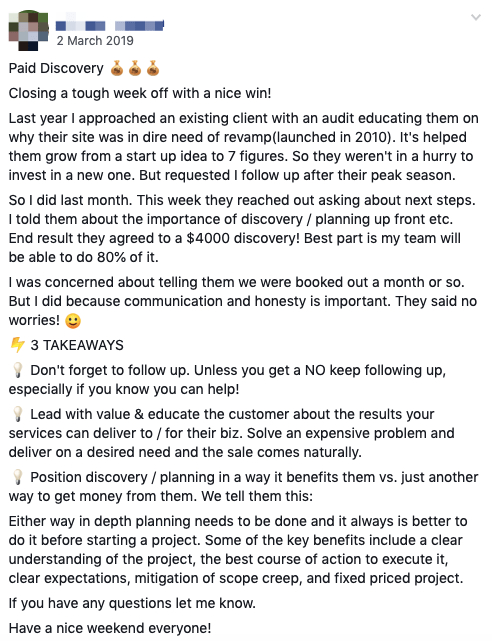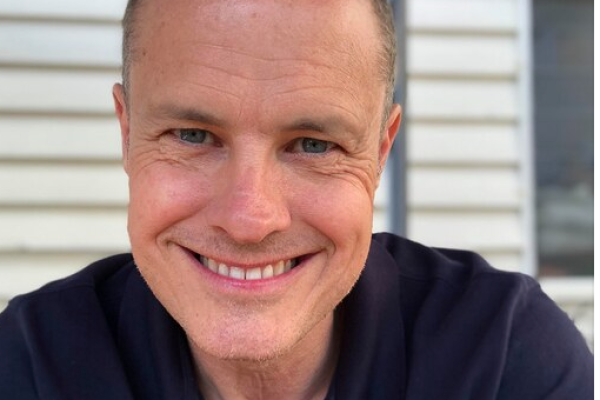This post was originally written by Simon Kelly in January 2020, and updated in September 2022.
I'm going to let you in on a little secret…
The way to earn more money and grow your business is to stop talking about deliverables and start talking about outcomes.
By focusing on outcomes, you position yourself as a business consultant.
Now, you might be thinking “But I'm a just web designer! What do I know about business consulting!?”
The answer? Well, the key to business consulting is to dig deeper and have conversations about business needs with potential clients.
Enter: Discovery Meetings
One of the ways that we teach our students to do that in our Blueprint Course is to run Discovery Sessions with their clients.
In a discovery session, your job is to guide your prospect / potential client to understand the business goals behind their projects. To do this, you need to dig deep and ask questions that may be a little awkward. But once you do, you can:
Get your foot in the door because the session is something of value. A discovery call is not just a sales call or meeting, it's a sales process that digs into their pain points from the first call.
Stop giving away your advice and time for free only for a potential client to go elsewhere or try to do it themselves! This way you can ensure subsequent meetings and get started on the next steps of the deal.
Be seen as the expert, someone who understands them, their business and their goals. Therefore, a partner in the process and much more likely to choose you for the project – the person they now trust. They're interested— they're no longer just potential clients or a prospect, but you're a team with a strong focus. Building rapport 101!
Here's just one example of a win from our Facebook group:

So let's start at the beginning, shall we?
What Is a Discovery Session?
When your potential client is not clear on exactly what it is that they want to do and why they want to do it – it's time to suggest a discovery session. This is the first step on the ladder to a successful discovery meeting. They probably haven't done a project like this before so they might not be clear on their goals or what they need their website to do in order to achieve those goals.
What Makes a Successful Discovery Meeting?
You can tell if a prospect is clear on their goals by the way they fill in their project enquiry form (you do have a project enquiry form, right!?). From there, use the Client Scorecard to assess the quality of this prospect and whether or not you think this is going to be a fantastic project.
If the goals they mention on the project enquiry form are not clear and they score well on the client scorecard, then this is when to pitch them a discovery session.
Some might even think they know what they want but… “they don't know what they don't know”. By the discovery meeting closing, your prospect will have a vested interest which can start the sales process in your next meeting.
Why Is a Discovery Meeting Important?
Not only will running the discovery session help you win the project but once you do, there are even more benefits:
It helps to minimise scope creep
Costing the project will be much more accurate
You'll know if you even want to work on the project, as you'll have done your own research
Working with the client will be so much easier because you're both on the same page
Download the free Discovery Session Workbook
How Do You Pitch a Discovery Session?
Pitching a discovery meeting is simple! Just tell the potential client that you are going to save them a lot of money, valuable time, effort, and additional resources by having the session. If you pitch it right, your prospect will be interested and hooked from the first call, and eager to learn the next steps on the agenda.
A Successful Discovery Session: The Next Steps
Moving forward, once they have agreed to the session make sure that you send an agreement and package it up with the proposal.
How Do You Price out a Discovery Session?
You should never run a discovery session for free because your potential client won't value it as much. You need to be paid for your time and services. Makes sense, right? No additional research needed there!
My advice is to price out the discovery session based on how much the project is going to cost. So charge around 10- 20% of what the final project is going to cost.
Discovery Meeting Structure
If you are conducting the session online such as in a video call, then a good time duration is about two hours for the whole meeting. For an in-person meeting, half a day would be a good fit for everybody to gain understanding.
You're just facilitating, so it is easy to deliver the meeting agenda. The key is to be comfortable in awkward silences because you don't necessarily need to give the answers straight away. The tendency is to talk, but you are simply a facilitator who asks the right questions and lets them lead the discovery phase with their exploration.
Discovery Meetings and Discovery Questions: Why, What, Who?
During the discovery process, have a conversation where you ask the client:
Why do you do what you do? Get on the same page (making money isn't an answer here!)
What are your products and services?
Who will benefit the most?
Who is your ideal customer?
What are your pain points?
Open ended questions that create conversation and lead to insights about the project are key here.
Discovery Meeting Goals: Dig Deeper!
What do they want to achieve? Use SMART goals and get as specific as you can. What does success look like for them? Who is their target market?
A SMART goal is Specific, Measurable, Achievable, Relevant and Time-Bound.
Asking “why” in your discovery meeting looks at the past. Asking “what for?” looks at the future.
Attract
Define the biggest problem in the marketplace. What does your client need to do to solve that?
Capture
How does your client start a conversation with their target audience? What's the first step they take? Do they outline the clear next steps? They need to capture their email address, phone number or the information that is valuable.
They need to start a meaningful conversation hopefully based on the information that they have captured. This may pose challenges and require more focus than they came to expect, but helps to ensure they are the right fit and can lead to the next call.
Nurture the Decision Maker
Email marketing is about giving clients info that is interesting and relevant to them and their specific goals.
The more you get into the “how to”, the less successful the discovery session will be. Get into the “What” they need to be doing during discovery sessions. The “How” is why they're going to hire you.
Next Steps: Convert Clients
The reason most leads do not convert into customers is that they are not sure what to do next.
Help the client identify their onboarding process and how they can take this process online. For example, an accounting firm might offer a business health check session and place an application form on their website with a payment option.
Part of the email nurture sequence should clearly state to leads how they can engage the services or buy the products.
Measure With Insights Gathered
It is possible to measure almost everything our website visitors and email subscribers do through online metric software such as Google Analytics and email marketing software like MailChimp. The problem is there is too much to measure and you can end up feeling overwhelmed by all the data.
Each organisation has one “magic metric” that, if improved in the next 90 days, will add the most value to the business. It could be visitors to the website, lead capture conversion rates, lead to client conversion rates, click-through rates from your emails, or any number of other metrics. Identify your “magic metric” based on your goals and your current situation.
Wrap Up
Make sure you download the complete template to take to your next discovery session. Like I said, once you have this with you, all you need to do is ask the questions and facilitate your client to put together the answers.
I'd love to hear how you go in your next discovery session using the template. Let me know in the comments below!




